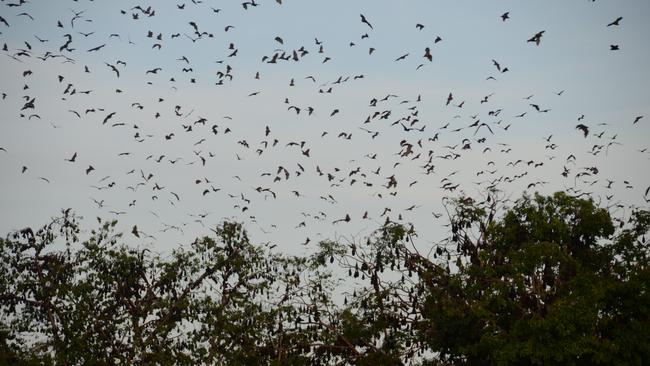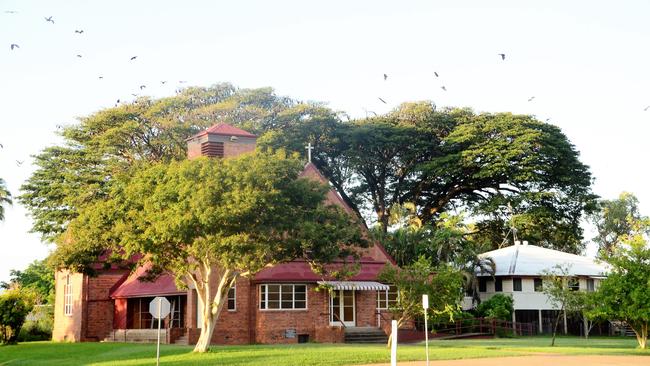Often pointed to as the Holy Grail of flying fox dispersals, Ingham’s 2020 CBD operation has become a much-talked-about topic among Charters Towers and Townsville residents battling with unlovable bats.
Ingham Mayor Ramon Jayo was the man who headed the 2020 bat-buster operation which drove a long-term roost of flying foxes out of the Ingham CBD, and has successfully kept them away ever since.
Mayor Jayo said the real secret to success was down to the Hinchinbrook Shire employees who wake up every morning to scare “scout” bats out of the CBD trees, 365 days a years.
“Our success is down to the hard work of our staff getting up at 4am every morning to get the scout bats out. That is critical,” Mayor Jayo said.
“We as a community are very thankful to the staff who do that, they are why we see success with our bat program.”

Mayor Jayo estimates the cost of keeping bats out of his town is around $3000 to $5000 a month – with activities and costs jumping up when the bats increase their efforts to return.
“They are always sending scouts back to see if it’s safe to return. There were a lot of bats born in that roost,” he said.
“You have to constantly be out there reminding them it’s not safe here anymore. It’s gotten to the point where they will fly away as soon as they see a council vehicle.”

The 2020 dispersal involved a large established colony of flying foxes being removed from the botanical gardens and adjoining properties, such as the Ingham State School.
“It had been a roost for many, many years,” Mayor Jayo said of the roost, which according to federal data had been a site used by four different species of bats since at least 2012.
“When I became the mayor, getting the bats out was one of the priorities we’d decided on… the state government did not want us to do this, they really worked hard to dissuade us from doing what we did. Their mantra was ‘you have to learn to live with them’.”

Mayor Jayo said he became “very disillusioned” with the state government.
“Our community was telling us they didn’t want to ‘learn to live with them’,” he said.
“The last government (Labor) their attitude was ‘we’re not going to help you at all’.”
Mayor Jayo said back in 2020, the environmental laws had a clause that meant if a flying fox roost was in an urban area, councils did not need state approval to conduct a dispersal – they only needed to notify authorities of their plan.

“I’m not criticising the laws, because you can work within them,” Mayor Jayo said.
“They are workable. We managed to work within them.”
Today if a flying fox roost has been declared as an ‘established roost’ by the Department of Environment, (the Federal government has a map online) councils need to take out a ‘damage mitigation permit’ in order to disperse them at their own cost.
State member for Hinchinbrook and KAP politician Nick Dametto worked very closely with the Mayor Jayo in 2020, and said he could “hand on heart” say the reason for Ingham’s success was the willingness of council staff to get on top of scouts every morning.

“It’s a commitment, but it’s like weed eradication. You don’t say ‘we’re been spraying here for three years we can stop now’ because that isn’t long enough to make a difference,” Mr Dametto said.
“We want to see flying foxes out in the wild, out in the bush pollinating like they should be. I want to see councils allowed to use more invasive methods to move them, and I want more financial support from the state government to fund dispersals.”
The 2020 Ingham dispersal started with research.
Mayor Jayo said before they did anything to disturb the bats, the council spent six months learning what the bats would do once they were lifted up.
“Anyone can lift the bats up, but they just come back down. Once we lifted them, we needed to do something with them,” he said.

The Hinchinbrook Shire Council ended up hiring environmental consulting service Biodiversity Australia to help them carry out the dispersal.
“Biodiversity Australia impressed us with the way they put the science behind it all, and it made sense,” Mayor Jayo said.
“We also got very good data from the CSIRO, because they have tracking devices on some bats and they gave us a lot of information and we were able to find areas the bats had colonised in the past.”
Armed with knowledge, the council identified multiple historical roost locations north, south, east and west of the CBD roost and started to lift the bats with pyrotechnics – or as Mayor Jayo puts: “we pressed the launch button”.

“We created a hullabaloo, once they lifted we watched and noticed the pattern of where they were going.”
Initially only a few bats were packing their bags and going, but these first groups were crucial to attracting the rest away from the CBD and council workers were taking notes of where the early-leavers had gone to.

Every day, a few more would follow the first bats to their new roost site, and this became the direction Hinchinbrook Shire Council would muster the remaining bats towards.
“Once we lifted them, it was like mustering, only you had to stay on the tail and follow them,” Mayor Jayo said.
When asked about why flying foxes seem to prefer roosting inside towns, Mayor Jayo said he believed human areas were attractive to the bats.

“I don’t accept this (roosting in towns) is because of habitat loss, because that’s not happening here in Hinchinbrook,” he said.
“We have a lot of national park around us, but I think they like the town because it’s warm, there are bright lights, there are insects, flowers, the parks and gardens are watered, and it’s safe.”
Five years later, and the Ingham roost is yet to re-establish in the botanical gardens, but waves of scout bats and their buddies are still beating at the door, a clear sign that this fight will be a long one.


Add your comment to this story
To join the conversation, please log in. Don't have an account? Register
Join the conversation, you are commenting as Logout
‘New way of doing business’: First-of-its-kind battalion raised
As Townsville based aviators prepare for the arrival of Apache helicopters, a new battalion has been created to increase the agility and capability of teams on the ground and in the sky.
‘Strength, courage’: Dad’s brave battle against fatal disease
A beloved Townsville dad struck down by deadly Melioidosis was meant to celebrate his 50th birthday this Friday — instead, his heartbroken family will gather to say their final goodbyes.